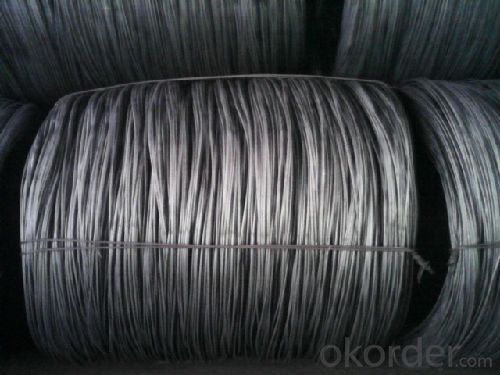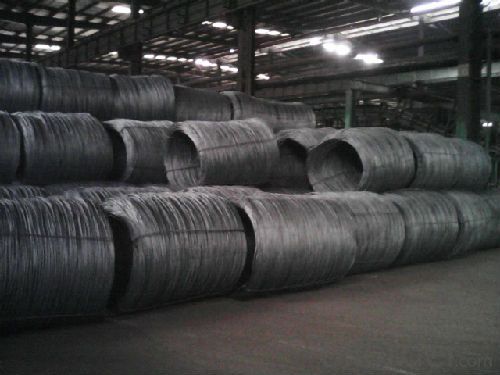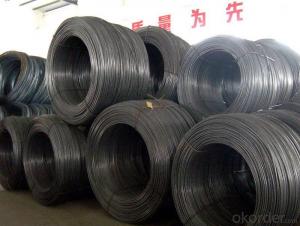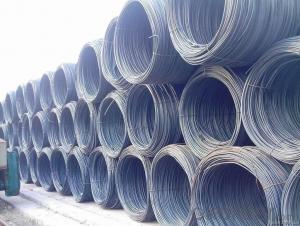Wire Rod High Qulity Hot Rolled Sae 1008b 5.5mmin Coils
- Loading Port:
- Tianjin
- Payment Terms:
- TT or LC
- Min Order Qty:
- 25 m.t.
- Supply Capability:
- 20000 m.t./month
OKorder Service Pledge
OKorder Financial Service
You Might Also Like
Product Description:
OKorder is offering Wire Rod High Qulity Hot Rolled Sae 1008b 5.5mmin Coils at great prices with worldwide shipping. Our supplier is a world-class manufacturer of steel, with our products utilized the world over. OKorder annually supplies products to European, North American and Asian markets. We provide quotations within 24 hours of receiving an inquiry and guarantee competitive prices.
Product Applications:
Wire Rod High Qulity Hot Rolled Sae 1008b 5.5mmin Coils are ideal for structural applications and are widely used in the construction of buildings and bridges, and the manufacturing, petrochemical, and transportation industries.
Product Advantages:
OKorder's Wire Rod High Qulity Hot Rolled Sae 1008b 5.5mmin Coils are durable, strong, and resist corrosion.
Main Product Features:
· Premium quality
· Prompt delivery & seaworthy packing (30 days after receiving deposit)
· Corrosion resistance
· Can be recycled and reused
· Mill test certification
· Professional Service
· Competitive pricing
Product Specifications:
hot rolled sae 1008b wire rod
1 .high quality
2. prompt delivery date
3. competive price and full size
| Product | wire rod |
| Standard | AISI,ASTM,BS,DIN,JIS,GB |
| Grade | Q195,Q235,SAE1006,SAE1008,SAE1018B,H08A,30MnSi,62B-82B |
| Diameter | 5.5mm-14mm |
| Coils weight | around 2 tons |
| MOQ | 100 Metric Ton,also depending on production schedule |
| Delivery Time | 25-45 Days |
| Packing | Standard export packing or as you required |
| Payment term | T/T, L/C |
| Application | construction |
FAQ:
Q1: Why buy Materials & Equipment from OKorder.com?
A1: All products offered byOKorder.com are carefully selected from China's most reliable manufacturing enterprises. Through its ISO certifications, OKorder.com adheres to the highest standards and a commitment to supply chain safety and customer satisfaction.
Q2: How do we guarantee the quality of our products?
A2: We have established an advanced quality management system which conducts strict quality tests at every step, from raw materials to the final product. At the same time, we provide extensive follow-up service assurances as required.
Q3: How soon can we receive the product after purchase?
A3: Within three days of placing an order, we will begin production. The specific shipping date is dependent upon international and government factors, but is typically 7 to 10 workdays.
Q4: What makes stainless steel stainless?
A4: Stainless steel must contain at least 10.5 % chromium. It is this element that reacts with the oxygen in the air to form a complex chrome-oxide surface layer that is invisible but strong enough to prevent further oxygen from "staining" (rusting) the surface. Higher levels of chromium and the addition of other alloying elements such as nickel and molybdenum enhance this surface layer and improve the corrosion resistance of the stainless material.
Q5: Can stainless steel rust?
A5: Stainless does not "rust" as you think of regular steel rusting with a red oxide on the surface that flakes off. If you see red rust it is probably due to some iron particles that have contaminated the surface of the stainless steel and it is these iron particles that are rusting. Look at the source of the rusting and see if you can remove it from the surface.
Images:



- Q:How is the hardness of steel wire rod measured?
- The hardness of steel wire rod is typically measured using a method called the Rockwell hardness test. This test involves pressing a diamond or hardened steel ball into the surface of the wire rod under a specific load, and then measuring the depth of the indentation that is made. The depth of the indentation is then used to determine the hardness of the wire rod. The Rockwell hardness test is widely used in the industry because it is relatively simple and provides accurate and consistent results.
- Q:What are the factors that affect the tensile strength of steel wire rod?
- The factors that affect the tensile strength of steel wire rod include the composition of the steel, the heat treatment process, the diameter of the wire, the presence of impurities, and the manufacturing technique used.
- Q:How is steel wire rod used in the manufacturing of wire for paper clips?
- Steel wire rod is essential in the wire manufacturing process for paper clips. It acts as the primary raw material that is converted into the end product. The production of wire for paper clips commences with steel wire rod, a long, cylindrical metal rod typically composed of carbon or stainless steel. To utilize steel wire rod, the first step is the drawing process, where the rod goes through a series of dies to decrease its diameter and increase its length. This drawing process enhances the wire's strength and flexibility, making it suitable for producing paper clips. Once the desired wire diameter is achieved, the steel wire rod undergoes further processing steps to create the wire used for paper clips. These steps may include different treatments like cleaning, annealing (heating and cooling), and coating, depending on the specific requirements of the paper clip manufacturer. During paper clip manufacturing, the wire is usually cut into specific lengths and bent into the familiar shape associated with paper clips. Steel wire rod is an ideal material for this purpose due to its exceptional strength and durability. It ensures that the paper clips maintain their shape and functionality even with repeated use. Moreover, steel wire rod provides the necessary rigidity to securely fasten the paper clip to a stack of papers while still allowing for easy insertion and removal. Its smooth surface and resistance to corrosion also prevent the wire from rusting, ensuring the longevity of the paper clips. To summarize, steel wire rod plays a crucial role in wire manufacturing for paper clips. It undergoes a series of processes to achieve the desired wire diameter and is then further treated and shaped to create the final product. Its strength, durability, and corrosion resistance make it an excellent choice of material for paper clip production, guaranteeing their functionality and longevity.
- Q:What are the different types of steel wire rod annealing furnaces?
- The industry commonly utilizes several different types of steel wire rod annealing furnaces. These furnaces serve the purpose of heating the wire rod to a specific temperature and gradually cooling it to improve its mechanical properties and minimize internal stresses. One example of an annealing furnace is the bell-type furnace, which consists of a cylindrical chamber with a movable cover or bell that seals the chamber during the annealing process. By utilizing electric heating elements or gas burners, the wire rod is heated to the desired temperature. This type of furnace is renowned for its efficient heat transfer and uniform temperature distribution, making it suitable for annealing large quantities of wire rod. Another type of annealing furnace is the pit furnace, which is constructed underground or in a pit and has a series of burners or heating elements positioned around the chamber. The wire rod is placed on trays or fixtures and loaded into the furnace for annealing. This furnace is commonly used for annealing smaller batches of wire rod and is recognized for its energy efficiency and versatility. Continuous annealing furnaces are also extensively employed in the wire rod industry. These furnaces feature a series of heating and cooling zones that enable continuous feeding of the wire rod for annealing. The wire rod is heated to the desired temperature and then cooled down using water or air jets. Continuous annealing furnaces are distinguished by their high production capacity and ability to anneal wire rod of various sizes and shapes. Additionally, there are specialized annealing furnaces such as roller hearth furnaces, walking beam furnaces, and rotary hearth furnaces. Each of these furnaces possesses unique designs and operational characteristics tailored for specific applications in the wire rod industry. Ultimately, the selection of an annealing furnace depends on factors such as production requirements, wire rod specifications, and cost considerations. It is crucial to choose the appropriate furnace type to ensure optimal annealing results and maximize the quality of the wire rod produced.
- Q:How is steel wire rod used in the manufacturing of wire forms for fishing nets?
- Steel wire rod is a crucial component in the manufacturing of wire forms for fishing nets. The wire rod serves as the raw material from which the wire forms are created. Firstly, the steel wire rod is processed through a series of steps to transform it into a usable wire form. This includes cleaning, annealing, and drawing the wire rod to achieve the desired diameter and tensile strength. These processes ensure that the wire is strong and flexible enough to withstand the tension and stress it will experience when used in fishing nets. Once the wire rod is transformed into wire, it is then used to create the various wire forms required for fishing nets. These wire forms include various components such as hoops, rings, loops, and connectors that are essential for constructing a functional fishing net. The wire forms are created using specialized machinery and techniques, including bending, cutting, and welding the wire according to the specific design requirements. These wire forms are then assembled together to form the net structure. The use of steel wire rod in the manufacturing of wire forms for fishing nets provides numerous advantages. Steel is known for its high strength and durability, making it ideal for withstanding the harsh conditions and constant tension that fishing nets are subjected to. Additionally, steel wire rod is resistant to corrosion, ensuring that the wire forms will have a long lifespan even when exposed to water and other environmental factors. In conclusion, steel wire rod is a vital component in the manufacturing of wire forms for fishing nets. It serves as the raw material from which the wire forms are created, providing the necessary strength, flexibility, and durability required for a functional fishing net.
- Q:How is steel wire rod used in the manufacturing of electrical wires?
- Steel wire rod is used in the manufacturing of electrical wires as the primary raw material. It is typically drawn through a series of dies to reduce its diameter and increase its length, resulting in a thin and flexible wire. This wire is then used to conduct electricity in various electrical applications, including power transmission, telecommunications, and electrical appliances.
- Q:How is steel wire rod used in the manufacturing of wire baskets and containers?
- Steel wire rod is an essential material in the manufacturing of wire baskets and containers. It serves as the primary component from which these products are constructed. The wire rod is typically made from high-quality steel and comes in various diameters, depending on the specific application and strength requirements of the wire baskets and containers. To create wire baskets and containers, the steel wire rod undergoes several manufacturing processes. First, it is drawn through a series of dies to reduce its diameter and increase its length. This process, known as wire drawing, helps to refine the wire rod and improve its tensile strength. After wire drawing, the steel wire rod is typically straightened and cut into specific lengths, depending on the desired size of the wire baskets and containers. It is then bent, twisted, or welded into the desired shape and structure, using specialized machinery and techniques. The steel wire rod's high strength and durability make it an ideal material for manufacturing wire baskets and containers. These products require sturdy construction to withstand heavy loads and resist bending or deformation. Steel wire rod provides the necessary strength and rigidity, ensuring that wire baskets and containers can safely hold and transport various items. Furthermore, the properties of steel wire rod make it highly resistant to corrosion and wear, ensuring the longevity of wire baskets and containers, even in harsh environments. This is particularly important for applications such as storage or transportation of goods in industries like agriculture, manufacturing, or logistics. In addition to its structural properties, steel wire rod also offers versatility in design. It can be easily manipulated into different shapes and sizes, allowing manufacturers to create wire baskets and containers that meet specific customer requirements. Whether it's a simple open-top basket or a complex container with dividers and handles, steel wire rod can be customized to suit various needs. Overall, the use of steel wire rod in the manufacturing of wire baskets and containers is crucial for ensuring the strength, durability, and functionality of these products. Its exceptional properties provide the necessary support and resistance to meet the demands of various industries, making steel wire rod an integral component in their production.
- Q:How are steel wire rods used in the manufacturing of mesh screens?
- Mesh screens rely heavily on steel wire rods as a fundamental ingredient in their production. These rods are typically crafted from top-notch steel, known for its robustness, longevity, and resistance to corrosion. The initial step involves selecting the appropriate grade of steel wire rod, based on the desired specifications for the mesh screen. The steel wire rods undergo a series of processes to prepare them for use. These processes include cleaning, straightening, and cutting, ensuring that the rods are devoid of impurities and possess the correct dimensions. Once the wire rods are prepared, they are fed into a mesh weaving machine. This machine is equipped with multiple weaving heads, which intertwine the wire rods both horizontally and vertically, creating a grid-like structure. The interlacing process can be performed in various patterns, such as plain weave, twill weave, or Dutch weave, depending on the intended application of the mesh screen. Throughout the weaving process, the steel wire rods are tightly woven together, resulting in a mesh that is both sturdy and flexible. This mesh structure offers numerous advantages, including heightened strength, resilience, and resistance to deformation. Following the weaving process, the mesh screens may undergo additional treatments to further enhance their properties. These treatments may involve heat treatment or surface coating, aiming to augment the mesh's resistance to rust, abrasion, or chemical corrosion, depending on the specific requirements of its application. In summary, steel wire rods play a pivotal role in the production of mesh screens by providing the essential material for weaving the mesh structure. The resulting mesh screens find application in diverse industries, such as construction, mining, agriculture, filtration, and security, among others. Their versatility, strength, and durability make them an ideal choice for a wide range of applications.
- Q:How is steel wire rod processed to achieve specific properties?
- Steel wire rod is processed through a series of manufacturing steps to achieve specific properties that make it suitable for various applications. The process begins with the selection of high-quality raw materials, typically low carbon steel, which is melted in a furnace to create molten steel. Once the molten steel is produced, it is then continuously cast into billets or blooms, which are solidified and then rolled into wire rod form through hot rolling. This hot rolling process involves passing the billets or blooms through a series of rollers to reduce their size and shape them into the desired wire rod dimensions. This step helps align the grain structure of the steel, improving its strength and ductility. After hot rolling, the wire rod undergoes a cooling process to relieve any residual stress and ensure dimensional stability. It is then subjected to a surface treatment, such as pickling or shot blasting, to remove any oxides or scale formed during the hot rolling process. To achieve specific mechanical properties, the wire rod may undergo further processing steps, such as cold drawing or heat treatment. Cold drawing involves pulling the wire rod through a series of dies to reduce its diameter, increase its tensile strength, and improve its surface finish. Heat treatment, on the other hand, involves subjecting the wire rod to controlled heating and cooling cycles to modify its microstructure, resulting in desired properties like hardness, toughness, or corrosion resistance. Additionally, the wire rod may undergo additional surface treatments, such as coating or galvanizing, to enhance its corrosion resistance or improve its aesthetic appearance. Coating can involve applying a layer of zinc, polymer, or other protective materials, while galvanizing involves immersing the wire rod in a bath of molten zinc to create a protective zinc coating. Overall, the processing of steel wire rod involves a combination of hot rolling, cooling, surface treatment, and potential further processing steps like cold drawing or heat treatment. These steps are carefully implemented to achieve specific properties, such as strength, ductility, corrosion resistance, and surface finish, making the wire rod suitable for diverse applications in industries like construction, automotive, manufacturing, and more.
- Q:How is steel wire rod used in the manufacturing of wire forms for automotive cooling systems?
- Steel wire rod is used in the manufacturing of wire forms for automotive cooling systems as it provides strength, durability, and resistance to corrosion. These wire forms are utilized in various components such as radiator support brackets, fan guards, and hose clamps. The steel wire rod is first drawn into the desired diameter and then undergoes processes like bending, cutting, and welding to create the required wire forms. These wire forms play a crucial role in ensuring the efficiency and functionality of automotive cooling systems by providing structural support, securing components, and maintaining proper airflow.
1. Manufacturer Overview |
|
|---|---|
| Location | |
| Year Established | |
| Annual Output Value | |
| Main Markets | |
| Company Certifications | |
2. Manufacturer Certificates |
|
|---|---|
| a) Certification Name | |
| Range | |
| Reference | |
| Validity Period | |
3. Manufacturer Capability |
|
|---|---|
| a)Trade Capacity | |
| Nearest Port | |
| Export Percentage | |
| No.of Employees in Trade Department | |
| Language Spoken: | |
| b)Factory Information | |
| Factory Size: | |
| No. of Production Lines | |
| Contract Manufacturing | |
| Product Price Range | |
Send your message to us
Wire Rod High Qulity Hot Rolled Sae 1008b 5.5mmin Coils
- Loading Port:
- Tianjin
- Payment Terms:
- TT or LC
- Min Order Qty:
- 25 m.t.
- Supply Capability:
- 20000 m.t./month
OKorder Service Pledge
OKorder Financial Service
Similar products
New products
Hot products
Related keywords




























